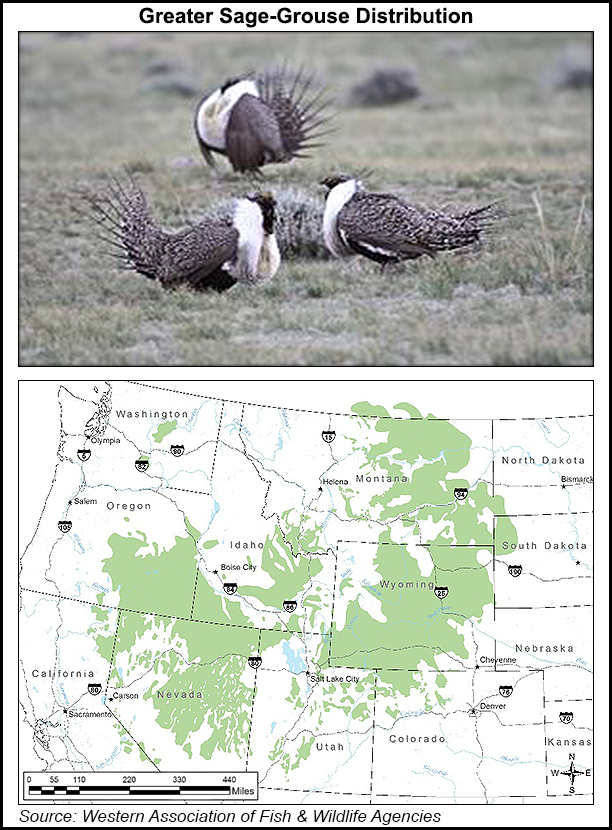Shale Daily | E&P | NGI All News Access | NGI The Weekly Gas Market Report | Regulatory
Forest Service Moves to Amend Sage Grouse Protection Plans
In another push to revise Obama administration environmental policies, the U.S. Forest Service (USFS) on Friday issued a draft environmental impact statement (DEIS) and amended land management plans covering sage grouse habitat in five western states including the Intermountain and Rocky Mountain regions.

The DEIS and revised plans were filed in the Federal Register (FR), kicking off a 90-day public comment period that ends Jan. 3 on the proposed changes, which stakeholders are characterizing as relatively modest compared to separate Bureau of Land Management (BLM) proposals released earlier this year.
Three years ago, energy industry, state and environmental officials came together to support a brokered move to protect the greater sage grouse with public-private conservation programs centered on the state level to prevent a listing under the Endangered Species Act (ESA). Federal officials at the time dubbed it the largest land conservation effort ever.
However, the USFS said it had accumulated additional information in the last three years, prompting the need for the land management plan amendments and the DEIS on potential impacts. The proposals apply to Colorado, Idaho, Nevada, Wyoming and Utah.
“The Forest Service has gathered information and determined that the conservation benefits of its plans in Nevada and other states can be improved,” said the FR post. “The Forest Service has identified proposed changes in the text of the greater sage grouse plan amendments which would improve their clarity and efficiency and better align them with the BLM and state plans.”
Earlier this year, BLM sought public comment on a proposal to reduce restrictions on oil and natural gas leasing in several western states with greater sage grouse habitat.
Last year a U.S. District Court Court for the District of Nevada ruled that the federal government could proceed with plans to protect sage grouse habitat in the state after a supplemental EIS was completed. Interior Secretary Ryan Zinke ordered a review of the federal plans to see if they were restricting energy production on public lands.
Now the USFS contends it wants to incorporate “new information and new science” into the plans after gathering more than 55,000 comments last year and another 8,700 this year. The Interior agency said the added input would improve the “clarity, efficiency and implementation of the greater sage grouse plans, including better alignment with BLM,” which is reviewing the impacts of the habitat plans on public lands.
USFS looked at three alternatives for possible amendments to the land management plans, with one keeping the status quo, a preferred second alternative and a third that would make additional changes to the second alternative in Utah only.
“The preferred alternative makes modifications to land management plans within the issue areas of ‘habitat management’ designation, including designating ‘sagebrush focal areas’ as priority habitat management areas,” USFS officials said.
In the third alternative, the “general habitat management areas” designation would be removed for USFS lands in Utah and remove the Anthro Mountain management area in Utah from the habitat management area designation on the Ashley National Forest.
Historically in the sage grouse saga, western states generally have maintained that they are better able to oversee dwindling habitat than are federal regulators. The Obama administration had estimated that 90% of the highest potential oil and gas development areas were outside the “priority” habitat lands.
© 2024 Natural Gas Intelligence. All rights reserved.
ISSN © 2577-9877 | ISSN © 1532-1266 | ISSN © 2158-8023 |
